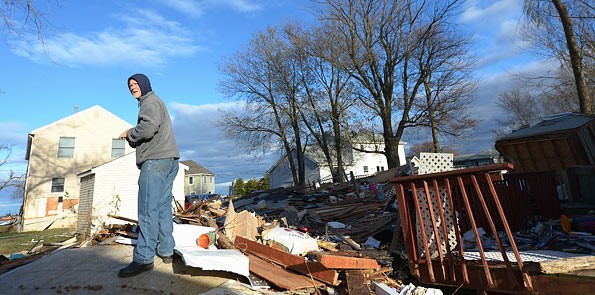
Some observers have been quick to proclaim the death of the Occupy movement, despite a hearty showing at anniversary rallies last month. Last week, here in storm ravaged New York, a healthy, versatile and vibrant movement came together to help fellow citizens at their time of greatest need.
A plethora of articles have sprung up in the storms aftermath (Slate, The New Yorker, Salon) suggesting Occupy Sandy, the burgeoning relief arm of the Occupy Wall Street movement, may be outflanking both city relief efforts and the Red Cross.
I first volunteered with Occupy Sandy on day three of the recovery. I made my way out to St Jacobi’s Church (no mean feat in gas constrained, public transit-less NY) in Sunset Park, a mostly immigrant neighbourhood in the west of Brooklyn. The church hall was a hive of activity, with a steady stream of donations coming in, and teams working on industrial scale food prep, sorting mountains of clothes and packaging up everything from batteries and blankets to diapers, formula and kids toys.
By midday, a caravan of cars and vans had been summonsed, and we packed them to the gunnels with hot food, water, and general supplies.
The drive out was frightening. It soon became clear we were in a disaster zone. Houses tilted wildly, driven off their foundations by the sheer power of the water. Cars, boats and shipping containers were tossed across lawns and into roads, and every home had a mounting pile of once-precious belongings in a sodden heap on the front lawn.
We arrived at the makeshift aid centre, immediately adjacent to about half a block of still smouldering rubble, to a queue of cold, hungry people snaking down the road. Despite only being functional for about five hours, word had clearly got around. We unloaded the hot food first, which volunteers began to serve, while the rest of us trucked in the shelving system and other supplies.
Later we went to another shop that had been donated to the cause, but that had sustained a fair bit of damage. Volunteers quickly got stuck in cleaning in the fading light in order to open another distribution point by the following day.
We did see one Red Cross van that afternoon, and a heavily guarded mayoral relief point. But it was clear the official relief effort hadn’t even begun to deal with the magnitude of the disaster. Occupy Sandy organisers believe they were the first ones on the ground in Rockaway, it’s undisputed that they hit Red Hook before any other efforts, and they now have sophisticated distribution networks in all of the worst hit areas.
They are clear they are providing mutual aid and supporting communities in need, rather than merely giving out donations. It remains to be seen how this cataclysmic event changes the make-up and mission of Occupy — or for that matter official disaster response efforts. In the meantime, a scrappy collective of anarchists, hippies and assorted activists are on the ground mucking out basements, keeping people fed and warm.
It may be proof positive of one of the maxims often associated with Occupy — another world is possible.
*Keiller Macduff works in New York as a media advisor to Greenpeace US







Congratulations to Greenpeace and to Keiller Macduff for getting involved constructively so early.